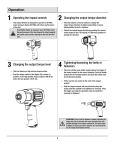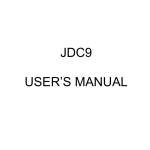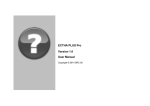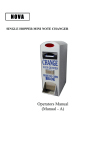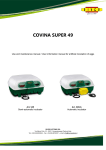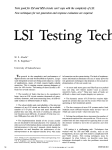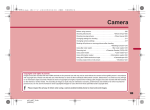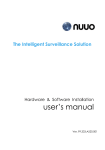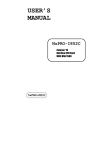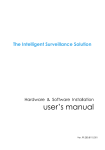Download Manual ECTHA 1000 pdf
Transcript
ECTHA 1000 Mechanical Hammer Manual Versione 1.02 Novembre 2012 MANUALE ISTRUZIONI INSTRUCTION MANUAL SCLEROMETRO MECCANICO CONCRETE TEST HAMMER Versione 1.02 Novembre 2012 DRC ® - Copyright Page 1 of 20 ECTHA 1000 Mechanical Hammer Manual Versione 1.02 Novembre 2012 General Index 1. Instructions pag.3 2. General Safety Standards pag.3 3. Reference Standards pag.4 4. Aim and Limitations of the sclerometrical examination nd fields of application pag.4 5. Sclerometer Operating System pag.5 6. Calibration Anvil characteristics and verification of sclerometer calibration pag.6 7. Selection and preparation of the test surface pag.7 8. Performing Test pag.8 9. Test Results pag.10 10. Test Report pag.10 11. Regression Curves pag. 11 12. Accessories pag.19 13. Component View pag.19 14. Guarantee validity pag.19 DRC ® - Copyright Page 2 of 20 ECTHA 1000 Mechanical Hammer Manual Versione 1.02 Novembre 2012 1. Instruction ▼ The following use manual contains safety standards as well as all the necessary instructions for the use of the sclerometer and the successive elaboration of the data obtained. To attain the maximum advantage of the use of the instrument it is recommended that all the instructions be read thoroughly and with utmost attention. The series number of the sclerometer is located on the external surface of the body (see the exploded view on page 35) while the calibration label has been placed at the rear of the body. The present manual is an integral and essential part of the product. It should be preserved with care for the whole life of the instrument. At such time as the manual is misplaced or lost for reasons unknown to DRC, then a new copy may be purchased separately. Always quote the data noted below when contacting a DRC representative or assistance laboratories. Model Serial Number Calibration date 2. General Safety Standards ▼ To prevent the risk of damaging the equipment or provoking damages to the operator or third parties, carefully read the following general safety standards prior to using the sclerometer. These standards should always be provided with the instrument, so that it may be consulted at any time by the user/operator. The manufacturer will not assume any responsibility for direct or indirect damages to persons, objects or domestic and non-domestic animals, due to the non-compliance of the safety standards contained in the present documentation. • The instrument must be used by adequately trained personnel, in order to avoid the improper use of the equipment. • The instrument must be solely used for its destined use for which it was designed. • The tampering and modification of the instrument is to be considered as negligent and isolates the manufacturer from any responsibility deriving DRC ® - Copyright Page 3 of 20 ECTHA 1000 Mechanical Hammer Manual Versione 1.02 Novembre 2012 from the misuse. In such a situation the guarantee for eventual spare parts or calibration verification will immediately cease to exist. • Do not perform or carry out any type of test with the instrument on any body part of person/s or animal/s: permanent damage and even grievous bodily harm may be caused by the use of the instrument on certain parts of the human/animal body. 3. Reference Standards ▼ The Ectha1000 sclerometer and the calibration anvil TAM100, manufactured by DRC srl save been constructed in order to operate within the guidelines set by the standard in-force which regulates the sclerometric examination, in particular: UNI EN 12504-2:2001(which replaces the UNI9189:1988) ASTM C805-2 4. Aim and Limitations of the Sclerometical Examinations and fiels of application ▼ The tests that may be performed on hardened concrete in operation, normal and pre-compressed reinforced concrete, in order to control the quality and estimate the mechanical characteristics the tests are divided into destructive and non-destructive tests. The “mechanical” method for the determination of the surface hardness via the use of the sclerometer is among the non-destructive tests. This method is based on the corresponding existence between the unitary load for compression breakage and the surface hardness of the conglomerate, by measuring the remaining elastic energy (bounce method). The sclerometric tests are used to estimate, with due limitations in the procedure, the compression resistance of the concrete in previously constructed structures. In fact the UNI EN 12504 -2:2001 at point 1, note 2, prescribes that the test method is not intended as an alternative for the determination of the resistance to compression of the concrete but, with an appropriate correlation, may provide an estimate of the resistance on site. The sclerometric index determined by this method may be used for the evaluation of the uniformity of the concrete on site, to delineate the zones or areas of poor quality or deteriorated concrete present in the structures. DRC ® - Copyright Page 4 of 20 ECTHA 1000 Mechanical Hammer Manual Versione 1.02 Novembre 2012 5. Sclerometer Operating System ▼ The principle for the function of the instrument is that a mass launched from a spring strikes a piston in contact with the surface and the result of the test is expressed in terms of the bouncing distance of the mass. The equipment is constituted by a mobile mass with a certain initial energy, which strikes the surface of a concrete mass. There is a redistribution of the initial kinetic energy following the strike and namely a part is absorbed by the concrete in the form of plastic or permanent deformation energy and another part of the energy is returned to the mobile mass which bounces for a tract in proportion to the remaining energy. An essential condition for the distribution of such energy is that the concrete mass is practically in infinite relationship with the mass of the mobile equipment, otherwise a part of the initial energy, being independent from the relative masses of the two bodies that will collide, would be transferred to the concrete in the form of kinetic energy. The condition for infinite mass for the concrete is realized by using very small impact masses. In order to obtain the necessary energy for the impact a spring system is used. The bounce run is determined by the energy of the bounce following the strike with the concrete and by the characteristics of the spring system. All the test devices that are based on the use of the results from the impact energy, must be equipped with a calibration control in that, after prolonged use, the springs modify their elastic constants. The mechanical sclerometer ECTHA 1000 has an impact energy of 2.207 N/m. Diverse types and forms of sclerometers for the control of various classes of resistance and types of concrete are commercially available. Each type and shape of sclerometer should only be used for the resistance class and concrete type for which it was intended and designed. The regression curves noted on page 1 are applicable only to the ECTHA 1000 sclerometer manufactured by DRC Srl Consequently DRC Srl will not guarantee the validity of the regression curves where other types of sclerometers are employed. DRC ® - Copyright Page 5 of 20 ECTHA 1000 Mechanical Hammer Manual 6. Calibration Anvil Features Versione 1.02 Novembre 2012 ▼ The stainless steel calibration anvil TAM100 for the sclerometer verification is characterized by a hardness of 57.60 HRC (Rockwell Hardness type C), by a mass of 16 kg and a diameter of about 150mm. The verification of the calibration of an anvil does not guarantee that diverse sclerometers will produce the same results in other points of the sclerometric scale. In order to verify the calibration of the sclerometer, the stainless steel anvil must be placed on a rigid surface. Operate the instrument at least three times prior to initiating the readings from the calibration anvil, to ensure that the mechanics are operating correctly. Then, following this procedure, insert the sclerometer in the anvil guide ring and carry out a series of strikes (no. ≥ 10). The average bounce index of the sclerometric strikes performed with the sclerometer Ectha1000 to the calibration anvil TAM100 must be 80 ± 2. DRC ® - Copyright Page 6 of 20 ECTHA 1000 Mechanical Hammer Manual Versione 1.02 Novembre 2012 7. Selection and Preparation of the test surface ▼ The concrete elements to be subjected to the test must be at least 100mm in thickness and fixed inside a structure. Smaller sample pieces may be subjected to testing as long as these pieces are rigidly supported. Areas that contain the presences of gravel nests, flaking, course textures or other porous elements and in the proximity of significant inertia must be avoided. It should also be avoided, by performing a preliminary Rebar Locator investigation, the carrying out of sclerometric strikes in areas of passing armatures and in the vicinity of pre-compression cables and wires. In the selection of an area to be subjected to the test the following factors should be considered: • Identification of the areas interested in the passage of armatures; • type of surface; • status of the surface humidity; • carbonatization; • movement of the concrete during the test; • evaluation of the damage level of the surface subject to the test; • test direction; • other appropriate factors as, for example, the type of concrete and the declared resistance class. The area to be subjected to the test must be approximately 300 mm x 300 mm. Ensure that the distance between the two points of impact are not less than 25 mm and that neither is less than 25 mm from the edge. The preparation of the test is carried out using an abrasive medium grain carborundum stone, provided with the instrument, to rectify the surfaces with rough or tender textures or surfaces with traces or mortar, in order to render the surfaces smooth. The smooth or float surfaces may be subjected to testing without rectification. Remove eventual water residue present on the cement surface. DRC ® - Copyright Page 7 of 20 ECTHA 1000 Mechanical Hammer Manual Versione 1.02 Novembre 2012 8. Performing Test▼ Unscrew the safety cap upon removing the sclerometer from its covering, lightly push the percussion rod inwards, compressing it towards a rigid surface. The rod will unhook and exit from the instrument body which is now ready for the test. Operate the instrument at least three times prior to taking any readings, in order to ensure that the mechanics are operating correctly. In order to facilitate the testing an appropriate station-template supplied with the instrument permits the marking of a normal line grid, with lines distancing from 25 to 50 mm and the intersection of the lines as examination points, on the element subject to the test. (fig. 1). Depress the percussion rod against the concrete surface under examination, maintaining the apparatus in perpendicular to the surface. Apply gradual to increasing pressure until the hammer unhooks. Maintain the apparatus firmly pressed against the examined surface, depress the halt pawl and read the value of the bounce index. Do not touch the halt pawl while pressing the percussion rod. Prior to carrying out a sequence of tests it is best to perform a sclerometer calibration using the stainless steel anvil of reference and check that it conforms to the limits recommended by the manufacturer (the average bounce index of the sclerometric strikes performed with the Modo-MH-N to the calibration anvil must be 80 ± 2). On the contrary contact the DRC sas assistance laboratories. The sclerometer should be used at a temperature between 10°C to 35°C. After the impact record the sclerometric index. Employ a minimum of nine measures in order to obtain a reliable estimate of the sclerometric index of a test area. Record the position and the orientation of the sclerometer for each measurement. Examine all the prints left on the surface after the impact and if the impact has shattered or perforated due to a gap near the surface, discard the result. After the tests, re-perform the sclerometer calibration check using the stainless steel anvil. If the result does not conform to the limits recommended by the manufacturer, annul the test and contact the DRC assistance laboratories. Humidity, carbonatization alterations, chemical aggressions, micro-cracks, composition and history of the concrete, status of the scabrous surface and underlying mass object of the percussion, are all elements that influence the bounce index value. DRC ® - Copyright Page 8 of 20 ECTHA 1000 Mechanical Hammer Manual Versione 1.02 Novembre 2012 A correctly proportioned concrete presents a highly alkaline (pH13) environment which inhibits the oxidization reactions of the armature. The concrete is however permeable therefore the carbon dioxide may distribute within reacting with the substances that it encounters giving way to the phenomenon of carbonatization (environment pH9) and to dimensional variations that determine the concrete cracks. The cracking sustains the penetration of both carbon dioxide and water vapor which in turn triggers another process: the oxidization of the armature bars/rods, with notable effects. The concrete altered by the carbonatization will cause an over-estimation of the resistance which in extreme cases may reach 50% (in effect the formation of calcium carbonate provokes a hardening of the surface strata). The presence of the carbonatization may be ascertained via a colorimetric test. The test is normally carried out by spraying (using a sprinkler) on the lateral surface of the cylindrical micro-samples, extracted via coring the elements subject to the test, with a phenolphthalein solution at 1% of ethyl alcohol (supplied with the instrument). The solution undergoes a color change once it is sprinkled going from a transparent white to a red-violet color when the surface results as not carbonatated; On the contrary where a surface is carbonatated the solution does not change remaining its transparent white color. It is possible to establish a correction factor of the readings obtained take into consideration the carbonatization phenomenon by comparing the sclerometric test results carried out on both the carbonatated surface and non-carbonatated below surface area. DRC ® - Copyright Page 9 of 20 ECTHA 1000 Mechanical Hammer Manual Versione 1.02 Novembre 2012 9. Test Result ▼ If over 20% of all the measures fluctuates from the average by more than 6 units, the entire set of measurements taken will have to be discarded. 10. Test Report ▼ The test report should include the following: a) identification of the element / concrete structure; b) position of the test area/s; c) sclerometer identification; d) description of the test area/s preparation; e) concrete details and conditions; f) date and hour of the test run; g) test result (average value) and orientation of the sclerometer for each test area; h) eventual deviations from the standardized test method; i) declaration of the person responsible for the test, whom can attest that the 12504-2:2001 test has been performed, excepting that referred to in point (h). Where necessary, the report may also include the single sclerometer readings. DRC ® - Copyright Page 10 of 20 ECTHA 1000 Mechanical Hammer Manual Versione 1.02 Novembre 2012 11. Regression Curves ▼ A correct application of the sclerometric method would theoretically require the mapping of correlation curves with reference to the material in operation. But as this operation is not practicable, above all with the objective difficulty of not knowing the manufacturer of the conglomerate, especially for non-recent structures, we can only limit the mapping of the regression curves based on the pre- packaged tests of available concrete, in the best hypothesis the concrete in use has same characteristics as that used in structures or at least analogous in composition. As for the rest the concrete resistance may be approximately estimated only in the presence of an experimental calibration curve which correlates the resistance of that concrete to the bounce index. In the absence of this estimate then a more general curve may be used which is supplied as support by the sclerometer manufacturer. In this regard an experimental campaign has been developed with reference to non-structural, ordinary, high performance and high resistance (from 5 N/mm2 to 100 N/mm2), conglomerates, obtainable by preparing particular ingredients and mix-design realizations. The mapping of the correlation curves has been obtained by simultaneously subjecting a total of 1000 samples to non destructive (determination of the sclerometric indexes) and destructive tests (crushing on the press) 50 test of cubic samples with sides of 200 mm by the 20 classes distinguished by the conglomerate as in table 1. DRC ® - Copyright Page 11 of 20 ECTHA 1000 Mechanical Hammer Manual Versione 1.02 Novembre 2012 Table 1 Class Number of Tests Resistance Concrete Category Class (N/mm2) 1 50 C6 2 50 C10 Non structural 3 50 C15 4 50 C20 5 50 C25 6 50 C30 7 50 C35 Ordinary 8 50 C40 9 50 C45 10 50 C50 11 50 C55 12 50 C60 13 50 C65 High 14 50 C70 Performance 15 50 C75 16 50 C80 17 50 C85 High 18 50 C90 Resistance 19 50 C95 20 50 C100 The various resistance classes obtained have been produced according to opportune mixes, using Portland cement and an assortment of inertias so as to represent typical standards for Italian concretes. The samples used in the experimental campaign were in the ideal conditions as required by the sclerometric method for the realization of correlation curves. In fact: • maturation period: 28 days; • relative humidity aspect: constant (not greater than 65%); • homogeneity of the concrete quality between the surface and deeper layers; • carbonatization phenomenon of the superficial layers: absent; • internal defects: absent. Each cubic test, at a maturation of 28 days, is subjected to the following: • accurate cleaning of surfaces via the medium grain abrasive stone in carborundum, in order to avoid that the sides of the sample could present scratches or nests of gravel or rough surface texture. Preventively a check DRC ® - Copyright Page 12 of 20 ECTHA 1000 Mechanical Hammer Manual Versione 1.02 Novembre 2012 of the surface was performed in order to ensure that it was dry, in order to avoid that it could alter the test result; • an accurate control of the dimensions and relative weight. For the measurements only three faces were considered from each sample, excluding in each the concrete casting side. In order to render the results of the sclerometric strikes as much as possible independent from the operator, DRC Srl has designed and constructed an apparatus known as ATHR (Alfa Test Hammer Robot) – patent no. AN2002A000028 which allows for automatic handling of the cubic tests between the plates of a press with a solicitation of 1 N/mm2, in order to hold them rigidly in place, impeding any movement during the impact. In this way it was possible to realize nine strikes in sequence for each face, via a video camera and external monitor it was possible to discern the inclination conditions of the instrument at a= -90°, 0° e +90° (where ‘a’ is the angle that the sclerometer axis forms with the horizontal). • at the crushing of the cubic samples, from the class 60 N/mm2 on the 3000 kN press (Metro Com of 4000 kN, model PI-MP 400 T with digital dynamometer) and from the class 65 N/mm2 up to the class 100 N/mm2 on the 5000 kN press (Controls 5000 kN, model C80/2 with digital dynamometer). A bewildering amount of points were obtained between the superficial hardness and the unit breakage load. In total 27000 sclerometric strikes were performed and 1000 press compression tests were also carried out. The experimental campaign was entirely performed at the DRC sas The three regression curves obtained by the experimental campaign, noted on page 1, are subdivided by each diverse inclination condition employed by the sclerometer. S2 = determining coefficient of the estimated values ( (Rci – Rvi) 2 S2 = [ 1 – ---------------- ] (0<S2<1) ( (Rci) 2 (( R2ci) – ---------n where Rci is the ima evaluated experimental resistance (N/mm2), DRC ® - Copyright Page 13 of 20 ECTHA 1000 Mechanical Hammer Manual Versione 1.02 Novembre 2012 Rvi is the ima evaluated resistance with the correlation formula R=a x Ib (N/mm2), n is the number of samples examined. when plus (s2) is approximate to the unit then the errors will more likely be minimal. DRC ® - Copyright Page 14 of 20 DRC ® - Copyright 0 10 20 30 40 50 60 70 80 90 100 110 120 0 5 10 15 20 25 35 40 Indice di rimbalzo (α= +90°) 30 S² = 0,9484 45 50 55 60 65 70 ECTHA 1000 Mechanical Hammer Manual Versione 1.02 Novembre 2012 Page 15 of 20 R e s is te n z a cu b ica a c o m p re s s io n e (N / m m ²) DRC ® - Copyright 0 10 20 30 40 50 60 70 80 90 100 110 120 0 5 10 15 20 25 35 40 Indice di rimbalzo (α= 0°) 30 S² = 0,956 45 50 55 60 65 70 ECTHA 1000 Mechanical Hammer Manual Versione 1.02 Novembre 2012 Page 16 of 20 Resistenza cubica a co m pressio ne (N/m m ²) DRC ® - Copyright 0 10 20 30 40 50 60 70 80 90 100 110 120 0 5 10 15 20 25 35 40 Indice di rimbalzo (α= -90°) 30 S² = 0,959 45 50 55 60 65 70 ECTHA 1000 Mechanical Hammer Manual Versione 1.02 Novembre 2012 Page 17 of 20 Resistenza cubica a compressione (N/mm²) ECTHA 1000 Mechanical Hammer Manual DRC ® - Copyright Versione 1.02 Novembre 2012 Page 18 of 20 ECTHA 1000 Mechanical Hammer Manual Versione 1.02 Novembre 2012 12. Accessories ▼ The padded covering encompassing the sclerometer includes the following: • Medium grain abrasive stone in carborundum; • Station template for measuring; • Phenolphthalein solution at 1% ethyl alcohol for the determination of carbonatization; • Pencil for mapping the grills for the measuring stations; • notes for test remarks. The sclerometer may also be equipped with a software that elaborates the results allowing the possibility to map out the regression curves for specific concrete mixes. . 13. Components view ▼ See image below 14. Guarantee Validity The mechanical organs of the sclerometer are guaranteed for 12 months from the date of purchase of the sclerometer. The cost of the calibration check and issue of the relative report will be evaluated from time to time according to the condition of the instrument. The guarantee loses its validity at such time as tampering with/or attempts at opening the instrument is/are verified. Reproduction of the instrument is prohibited. All rights reserved. No part of the present operation manual may be reproduced or distributed in any manner, nor photocopy, microfilm or other, without the written consent of DRC Srl All the products may be subject to modification without warning. DRC ® - Copyright Page 19 of 20 ECTHA 1000 Mechanical Hammer Manual DRC ® - Copyright Versione 1.02 Novembre 2012 Page 20 of 20




















